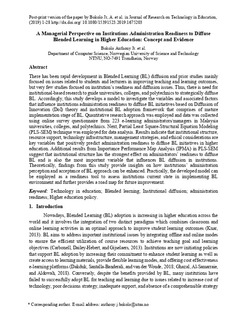A managerial perspective on institutions’ administration readiness to diffuse blended learning in higher education: Concept and evidence
Journal article, Peer reviewed
Accepted version

Åpne
Permanent lenke
http://hdl.handle.net/11250/2628248Utgivelsesdato
2019Metadata
Vis full innførselSamlinger
Originalversjon
https://doi.org/10.1080/15391523.2019.1675203Sammendrag
There has been rapid development in Blended Learning (BL) diffusion and prior studies mainly focused on issues related to students and lecturers in improving teaching and learning outcomes, but very few studies focused on institution’s readiness and diffusion issues. Thus, there is need for institutional-based research to guide universities, colleges, and polytechnics to strategically diffuse BL. Accordingly, this study develops a model to investigate the variables and associated factors that influence institutions' administration readiness to diffuse BL initiatives based on Diffusion of Innovation (DoI) theory and institutional BL adoption framework that comprises of mature implementation stage of BL. Quantitative research approach was employed and data was collected using online survey questionnaire from 223 e-learning administrators/managers in Malaysia universities, colleges, and polytechnics. Next, Partial Least Square-Structural Equation Modeling (PLS-SEM) technique was employed for data analysis. Results indicate that institutional structure, resource support, technology infrastructure, management strategies, and ethical considerations are key variables that positively predict administration readiness to diffuse BL initiatives in higher education. Additional results from Importance Performance Map Analysis (IPMA) in PLS-SEM suggest that institutional structure has the strongest effect on administrators’ readiness to diffuse BL and is also the most important variable that influences BL diffusion in institutions. Theoretically, findings from this study provide insights on how institutions’ administration perception and acceptance of BL approach can be enhanced. Practically, the developed model can be employed as a readiness tool to assess institutions current state in implementing BL environment and further provides a road map for future improvement.